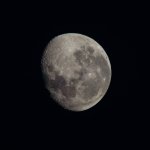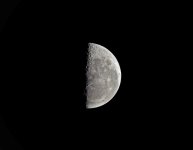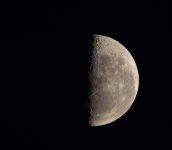You are using an out of date browser. It may not display this or other websites correctly.
You should upgrade or use an alternative browser.
You should upgrade or use an alternative browser.
Photos from the D3200
- Thread starter brads
- Start date
sOnIc
Senior Member
Hi Brad. These have already had white balance, exposure, levels, straightening, cropping, shake reduction, contrast with gradient mask, and a bit of vibrance... tho a bit rushed... the originals look very poor in comparison, low light and focussed for the distance not the foreground...
sOnIc
Senior Member
Ah yes that's more like it Brad : ) And yes upside down, we're used to seeing Tyco and its rays coming out from the bottom, but for you it's the crater in the top middle, notice how its rays extend a long way around the Moon. Nice cratering now it is a few days off full moon, great image!
brads
Senior Member
Ah yes that's more like it Brad : ) And yes upside down, we're used to seeing Tyco and its rays coming out from the bottom, but for you it's the crater in the top middle, notice how its rays extend a long way around the Moon. Nice cratering now it is a few days off full moon, great image!
Tyco eh? I'm a space ignoramus I shall freely admit. Although it's fascinating when seen through the eyes of a camera and I can understand people's passion for it.
Notice that the focus is better at the bottom left of the frame? It's a shame that I couldn't get focus at the top also. But boy, that lens is heavy, even on the tripod. And wobbly. Just touching it to focus makes it difficult to see. This is a cheaper 500ml lens; I wonder if the better ones have auto focus? Or do you use a telescope? Can you explain how in a few words? Cheers, Brad
sOnIc
Senior Member
The night sky is a whole world above your head, and for me sharing it with others is one of the most rewarding things in life. A great viewing tool for the night sky is binoculars on a tripod, telescopes are too 'zoomed' for many objects and there's a lot more detail up there than most people are aware of, bins are excellent. But even with the naked eye; if you dark adapt your eyes properly on a moonless night you will notice all sorts of interesting groupings and blurry objects that make you want to know more; and moving objects too (satellites etc), always something new to see, always breathtaking; but even more so if you understand what those objects are!
Focus wise I am in the same situation with my 70-300mm, using it for the first time without auto-focus since the D3200 has no motors, that makes me want to upgrade asap. Like my lighthouse/Moon shots a few days ago, I used F9 because I was struggling to get perfect focus and it made it more forgiving, but it's always a compromise with shutter speed. One very useful accessory would be a cheap 2x viewfinder adapter, this fits onto the normal viewfinder but giving you some magnification and assistance with manual focussing; particularly when you need to focus on a star for doing star-trails for example.
Astrophotography really has very little to do with 'normal' photography, requiring motorised telescopes; light-weight CCD/CMOS imagers, narrowband filters, and software stacking etc. I did see your stacked flower picture which was very good! I assume you were doing something similar, but certainly to get proper images of the Moon or deep sky objects such as galaxies and nebulae then you would use specialist equipment - that doesn't necessarily mean expensive, but its certainly going to involve a computer; and leaving the DSLR free to do something like a star trail!
For a DSLR I'd say the best application is star trails: on a moonless night; put the camera on a tripod with a wide-angle lens like the 18-55, minimum f-stop, zoom in and focus on the brightest star you can see, pull back and compose your shot, then let the camera expose for 10 minutes or more .. ideally 30 mins or more, depending on light pollution, and also you have to watch for dew forming on the lens; I have a heater to stop that .. Onboard NR is fine; but you need a full battery as it will take 30 mins to do with a 30min shot. Actually harder is getting a good night sky image without trailing; I found I can get away with 7 seconds at 18mm; then boost the exposure with raw tools - I'm yet to get a 'good' non-trailed shot of the Milky Way. But its mostly about your choice of location; foreground objects; constellations visible etc, endless creative options : )
(A few words?! ^ Nevermind, get out there people! )
Focus wise I am in the same situation with my 70-300mm, using it for the first time without auto-focus since the D3200 has no motors, that makes me want to upgrade asap. Like my lighthouse/Moon shots a few days ago, I used F9 because I was struggling to get perfect focus and it made it more forgiving, but it's always a compromise with shutter speed. One very useful accessory would be a cheap 2x viewfinder adapter, this fits onto the normal viewfinder but giving you some magnification and assistance with manual focussing; particularly when you need to focus on a star for doing star-trails for example.
Astrophotography really has very little to do with 'normal' photography, requiring motorised telescopes; light-weight CCD/CMOS imagers, narrowband filters, and software stacking etc. I did see your stacked flower picture which was very good! I assume you were doing something similar, but certainly to get proper images of the Moon or deep sky objects such as galaxies and nebulae then you would use specialist equipment - that doesn't necessarily mean expensive, but its certainly going to involve a computer; and leaving the DSLR free to do something like a star trail!
For a DSLR I'd say the best application is star trails: on a moonless night; put the camera on a tripod with a wide-angle lens like the 18-55, minimum f-stop, zoom in and focus on the brightest star you can see, pull back and compose your shot, then let the camera expose for 10 minutes or more .. ideally 30 mins or more, depending on light pollution, and also you have to watch for dew forming on the lens; I have a heater to stop that .. Onboard NR is fine; but you need a full battery as it will take 30 mins to do with a 30min shot. Actually harder is getting a good night sky image without trailing; I found I can get away with 7 seconds at 18mm; then boost the exposure with raw tools - I'm yet to get a 'good' non-trailed shot of the Milky Way. But its mostly about your choice of location; foreground objects; constellations visible etc, endless creative options : )
(A few words?! ^ Nevermind, get out there people! )
raggamuffin
Senior Member
It's my second day with my first ever DSLR. I went o Ely Cathedral which is in a tiny city very near to my house. It's one of the most beautiful buildings i've ever seen and construction spanned nearly 300 years.
Hope this link works
https://www.facebook.com/media/set/...073741833.100002071012660&type=1&l=2777977d72
Ed
Hope this link works
https://www.facebook.com/media/set/...073741833.100002071012660&type=1&l=2777977d72
Ed
brads
Senior Member
Boo! your becoming quite a Lycanthrope Brad, I'm dreading the full moon
That's funny...I had to go and look up what it Lycanthrope meant! I'm HOWLING with laughter. Cheers, Brad
Brandonberg
Senior Member
Great thread! Anyone know if a thread like this one has been made for the D3100?
Would love to post some pics in a similar fashion but don't own a D3200
Would love to post some pics in a similar fashion but don't own a D3200
I had a D3100 and have a few piccis, don't know how hard and fast the rules are (any moderators wanna chime in) but my view would be "the more the merrier" and you do have the D3200s slightly less endowed brother
Anyway the sky in Blackburn is a funny blue colour instead of that nice grey, so I am going to try my camera in this bright light.
Continuing with the bad puns, here is a photo taken a few days ago, entitled:
"Wasp for tea Mummy"
Anyway the sky in Blackburn is a funny blue colour instead of that nice grey, so I am going to try my camera in this bright light.
Continuing with the bad puns, here is a photo taken a few days ago, entitled:
"Wasp for tea Mummy"
Attachments
shungokusatsu29
Senior Member
Don Kuykendall_RIP
RIP :(
I had a D3100 and have a few piccis, don't know how hard and fast the rules are (any moderators wanna chime in) but my view would be "the more the merrier" and you do have the D3200s slightly less endowed brother
Anyway the sky in Blackburn is a funny blue colour instead of that nice grey, so I am going to try my camera in this bright light.
Continuing with the bad puns, here is a photo taken a few days ago, entitled:
"Wasp for tea Mummy"
There should be a thread like this for the 3100 it is really better to keep the models separate for this type discussion. If there is no thread then PM me and I will make one and make it a sticky.
Sent from my iPhone using Tapatalk 2
sOnIc
Senior Member
Really good cratering on those images Brad, half moon for greatest shadowing of-course, though I'm sort of preferring the first version because of the colour and definition.
Brandonberg - I have no authority; but if you need a thread called "Photos from the D3100" then I'd say do it!
Feilong - nice panorama; almost looks like you are onboard an aircraft or something, great location : )
Brandonberg - I have no authority; but if you need a thread called "Photos from the D3100" then I'd say do it!
Feilong - nice panorama; almost looks like you are onboard an aircraft or something, great location : )
Brandonberg
Senior Member
Really good cratering on those images Brad, half moon for greatest shadowing of-course, though I'm sort of preferring the first version because of the colour and definition.
Brandonberg - I have no authority; but if you need a thread called "Photos from the D3100" then I'd say do it!
Feilong - nice panorama; almost looks like you are onboard an aircraft or something, great location : )
Im going to do it!





